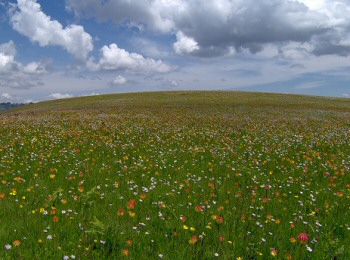[google-translator]
Locals refer to the Kitulo Plateau as Bustani ya Mungu – The Garden of God – while botanists have dubbed it the Serengeti of Flowers, host to ‘one of the great floral spectacles of the world’. And Kitulo is indeed a rare botanical marvel, home to a full 350 species of vascular plants, including 45 varieties of terrestrial orchid, which erupt into a riotous wildflower display of breathtaking scale and diversity during the main rainy season of late November to April.
Perched at around 2,600 metres (8,500 ft) between the rugged peaks of the Kipengere, Poroto and Livingstone Mountains, the well-watered volcanic soils of Kitulo support the largest and most important montane grassland community in Tanzania.
One of the most important watersheds for the Great Ruaha River, Kitulo is well known for its floral significance – not only a multitude of orchids, but also the stunning yellow-orange red-hot poker and a variety of aloes, proteas, geraniums, giant lobelias, lilies and aster daisies, of which more than 30 species are endemic to southern Tanzania.
Big game is sparsely represented, though a few hardy mountain reedbuck and eland still roam the open grassland.
But Kitulo – a botanist and hiker’s paradise – is also highly alluring to birdwatchers. Tanzania’s only population of the rare Denham’s bustard is resident, alongside a breeding colony of the endangered blue swallow and such range-restricted species as mountain marsh widow, Njombe cisticola and Kipengere seedeater. Endemic species of butterfly, chameleon, lizard and frog further enhance the biological wealth of God’s Garden.
About the Kitulo Plateau National Park
Size: 412.9 sq km (159 sq miles)
Location: Southern Tanzania.
The temporary park headquarters at Matamba are situated approximately 100km (60 miles) from Mbeya town.
Getting there
4×4 only.
From Chimala, 78km east of Mbeya along the surfaced main road to Dar es Salaam, head south along the rough but spectacular dirt road – called Hamsini na Saba (57) after the number of hairpin bends along its length – to the temporary park headquarters at Matamba, from where it’s another hour’s drive to the plateau.
Basic and erratic public transport is available.
What to do
Good hiking trails exist and will soon be developed into a formal trail system.
Open walking across the grasslands to watch birds and wildflowers.
Hill climbing on the neighbouring ranges. A half-day hike from the park across the Livingstone Mountains leads to the sumptuous Matema Beach on Lake Nyasa.
When to go
Wildflower displays peak between December and April.
The sunnier months of September to November are more comfortable for hiking but less rewarding to botanists.
Conditions are cold and foggy from June to August.
Accommodation
Mbeya is serviced by everything from luxury hotels to simple guesthouses, while two simple guesthouses also exist in Matamba.
There is no accommodation in the park as yet, but very basic accommodation and meals are available at the adjacent Kitulo Farm.
Three special campsites are planned within the park, catering to fully equipped campers.
Two moderately priced church-run hostels are situated on Matema Beach
This is the end of our “”
Thank you for your interest to our programs. We hope that you will use the form below to book your safari with Travel Closer
Note: We can customize this program to carter your budget and safari expectations
PRICING TERMS
Price Includes:
|
Price Excludes:
|

